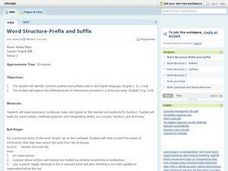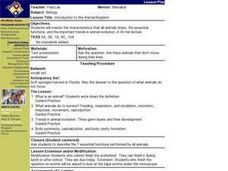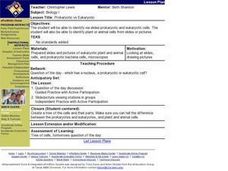Curated OER
Heat Unit
Students define thermal equilibrium. They distinguish between internal energy and heat. Students describe how the quantity of heat that enters or leaves a substance is measured.
Curated OER
Word Structure-Prefix and Suffix
Students identify the common prefixes and suffixes used in the English language. They dissect a word into its various (root, prefix, suffix) parts and use a dictionary to determine the proper usage and derivation of each word part. ...
Curated OER
CSI: Native America
Students discuss the murders of Native Americans in Indiana. In groups, they research and make drawings of the scene as if they were part of a CSI team. They complete any needed experiments to help them solve the crime and create a...
Curated OER
Using a Dichotomous Key for Invertebrate Phyla
Learners use a key to determine the phyla of invertebrates. They are broken into groups and each group gets a stack of pictures and uses the key to determine which phyla the animal belongs to. There are also individual questions for...
Curated OER
Hatching Brine Shrimp
Learners experiment with temperature and salinity to detect favorable environments for hatching brine shrimp eggs. They make some predictions about which environments will yield the most hatched brine shrimp and record the number of...
Curated OER
Tree Friends
Students are introduced to tree structure and use. They identify their special tree using all senses except sight. Students identify six different internal parts within a cross section of tree trunk (bark, phloem, xylem, cambium,...
Curated OER
Introduction to the Animal Kingdom
Students are asked: Are there animals that don't move during their lives. They are asked what is an animal? Students discuss what animals need to survive. They are taught the trends in animal evolution. Students discuss the three...
Curated OER
Prokaryotic vs Eukaryotic
Young scholars identify via slides prokaryotic and eukaryotic cells. They identify plant or animal cells from slides or pictures. Students are given the question of the day. They are asked which has a nucleus, a prokaryotic or...
Curated OER
Build-A-Horseshoe Crab
Students discover many facts about horseshoe crabs. Students identify the main body parts of horseshoe crab. They explore the habits of the horseshoe crab and their importances to the ecosystem. Adaptations for younger students are...
Curated OER
CSI Clamshell Investigation
Pupils explore and explain how moon snails eat and where the holes in clamshells come from and then draw conclusion from the data collected. They incorporate math and graphing skills to determine if there is a relationship to a clam's...
Curated OER
Elements And Atoms
Students investigate the concept of elements and atoms. They conduct research using a variety of resources and use the information in order to create a class presentation. The activity includes specific dialogue and steps for the teacher...
Curated OER
Outbreak!
Students study and research drug-resistant bacteria and the use of antibiotics. Through the use of the internet, and other resources, students gather information and create a board game. They discuss bacteria, antibodies, antibiotics...
Curated OER
Barn Owl Pellet Lab
In this lab learning exercise, learners dissect a barn owl pellet then identify the different small animals found in the owl pellet. Using class data they calculate percentage present as well as complete 8 post lab questions.
Curated OER
Job Cards
In this job matching worksheet, young scholars match up nine colored cards to nine black and white cards to nine title cards for each profession shown.
Curated OER
What is an animal?
For this animal worksheet, students determine which characteristic of an animal matches the given statement. Students describe illustrations of animals using the terms radial symmetry, bilateral symmetry, and no symmetry.
Curated OER
The History of Life
In this origin of life worksheet, students will review the different theories on how life originated on the Earth including the experiments conducted by Louis Pastuer, Francesco Redi, and Miller and Urey. Students will complete 14 fill...
Curated OER
Light and Vision
In this light and vision worksheet, students will review the characteristics of light including how the eyes use light to see. This worksheet has 9 fill in the blank, 8 true or false, 9 multiple choice, and 1 short answer question.
Curated OER
Detecting Disease
In this detecting disease activity, students will review the different tools scientists use to identify diseases including the steps of Koch's postulates. This activity has 14 fill in the blank and 4 short answer questions.
Curated OER
Reproduction
In this reproduction worksheet, students review the processes involved with sexual reproduction in animals and pollination in plants. This worksheet has 6 fill in the blank, 5 true or false, and 9 short answer questions.
Curated OER
The Respiratory System
In this respiratory system worksheet, students review how the air passageways and lungs transport oxygen through the respiratory system. Students also review the mechanics of breathing. This worksheet has 6 multiple choice and 6 true or...
Curated OER
Finding Roots and Newton's Method
In this roots worksheet, students identify the local maxima and minima for a function. Students find the roots of the function using roots and Newton's Method of approximation. This three-page worksheet contains examples, explanations...
Curated OER
DNA - The Double Helix
In this DNA worksheet, students read information about DNA and messenger RNA. Then students complete 16 short answer questions and color 2 images.
Curated OER
Flatworms- Observations of a Live Planarian
In this flatworm worksheet, learners observe a flatworm in a petri dish. Students describe the flatwork and measure the planarian. Learners complete the various charts about the movement and observations of the planarian.
Curated OER
The History of Life
In this history of life activity, students complete a crossword puzzle by figuring out the vocabulary words associated with the 11 clues given. Then students review how paleontologists use fossils to learn more about past living things...
Other popular searches
- Parts of a Microscope
- Compound Microscopes
- Label Compound Microscope
- Dissection Microscopes
- Microscope Cheek Cells
- Digital Microscope
- Microscope Lab
- Biology Lab Microscopes
- Scanning Electron Microscopes
- Cheek Cells and Microscopes
- Lesson Plan on Microscopes
- Lenses and Microscopes

























